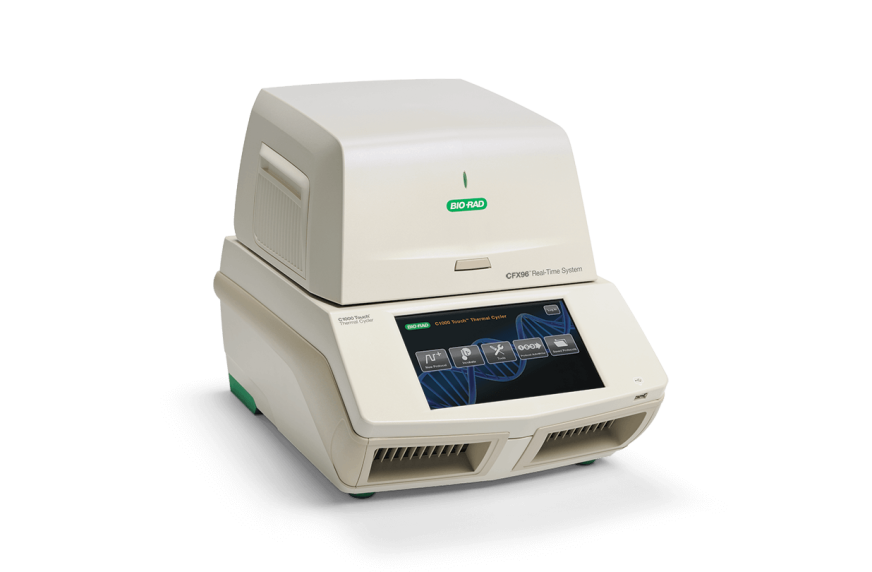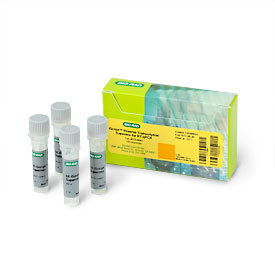
Overview
Product Discontinuation
The CFX96 Touch and CFX384 Touch Real-Time PCR Detection Systems will be discontinued soon. Please see the CFX Opus Real-Time PCR System for alternative products. If you are interested in purchasing a CFX Touch unit, complete this form, and one of our sales representatives will contact you. We will continue to provide support for the CFX96 Touch and CFX384 Real-Time PCR Detection Systems until December 2026.
The CFX96 Touch System is a powerful, precise, and flexible real-time PCR detection system. This six-channel (five colors and one FRET channel) real-time PCR instrument combines advanced optical technology with precise temperature control to deliver sensitive, reliable detection for singlexplex or multiplex reactions.
Quickly set up runs and monitor amplification traces in real time on the integrated LCD touch screen, or use the included CFX Maestro Software to easily and intuitively design your experiment and analyze results from a connected computer. With up to five-target detection, unsurpassed thermal cycler performance, unrivaled stand-alone functionality, and powerful yet easy-to-use software, the CFX96 Touch System is designed to advance your qPCR.
Key Features and Benefits
With the CFX96 Touch Real-Time PCR Detection System you can:
- Set up your system quickly — easy installation and factory-calibrated optics
- Minimize sample and reagent use — up to 5-target multiplexing with sample volumes as low as 10 µl
- Optimize reactions in a single run — thermal gradient feature
- Analyze data faster — visualize all run data at once and export only the data you need in the format you want
- Use advanced data analysis tools — normalized gene expression using CFX Maestro Software
- Configure the system to fit your needs — run without a computer, run up to 4 systems from 1 computer, or integrate with the CFX Automation System II for higher throughput
- Combine the CFX96 Touch System with good laboratory practice standards — use CFX Maestro Software, Security Edition for data collection and analysis to simplify compliance with U.S. FDA 21 CFR Part 11 regulations
Flexible CFX System Configurations Meet Your Throughput Needs
The CFX Automation System II works with all CFX Real-Time PCR Detection Systems to enable walk-away, high-throughput qPCR operation. Integrate this robotic plate handler with one or two CFX Systems to maximize throughput while maintaining a compact footprint.

CFX Maestro Software Works Seamlessly with PrimePCR Assays and Panels
The expert design and wet-lab validation of all PrimePCR Assays ensure optimal assay performance. The integration of CFX Maestro Software with PrimePCR Assays aids in the analysis and interpretation of experimental results.
- Begin analyzing data in a single step by importing target, reference, and control information from a PrimePCR run file directly into CFX Maestro Software
- Combine data from multiple plates into a Gene Study to rapidly screen large numbers of targets or samples
- Use powerful data visualization tools, such as hierarchical clustering and color-matched expression levels, to identify individual targets or clusters to consider for further investigation
Service Plans and Validation Tools for CFX Systems, Thermal Cyclers, and Real-Time PCR Instruments
- The Bio-Rad Expert Care Service Program offers various service plans to keep your systems functioning optimally
- CFX System IQ/OQ Services and CFX Automation System II IQ/OQ Services certify system installation and validate system performance
- Thermal Validation Services test temperature accuracy and uniformity
- The CFX Qualification Plate quickly and easily verifies the performance of your CFX Real-Time PCR Detection Systems
Related Technologies
Related Products
Specifications
Ordering
items
Use the filters below to refine results!


Accessories


Kits & Reagents



500 x 20 µl reactions, 5 ml (5 x 1 ml), 2x qPCR mix, contains dNTPs, iTaq DNA Polymerase, MgCl2, SYBR® Green I, enhancers, stabilizers, and a blend of passive reference dyes


1.25 ml (1 x 1.25 ml), 2x PreAmp Mix contains dNTPs, Sso7d fusion polymerase, salts, enhancers, stabilizers, and other proprietary components, for 50 x 50 µl reactions

Pkg of 1, kit includes SingleShot Cell Lysis Reagents, iScript™ Advanced cDNA Synthesis Kit for RT-qPCR, SsoAdvanced™ Universal SYBR® Green Supermix, and the SingleShot RNA Control, for 100 x 50 µl reactions


Plastics

Pkg of 50, white shell/clear well PCR plate, rigid 2-component design

Pkg of 50, white shell/clear well PCR plate, barcoded, 7-digit sequential, Code 128, rigid 2-component design





Pkg of 120, thin-wall polypropylene 8-tube strips for PCR and low-volume reactions, clear (960 tubes)

Pkg of 120, thin-wall polypropylene 8-tube strips for PCR and low-volume reactions, white (960 tubes)

Pkg of 120, 8-cap strips for 0.2 ml tubes and plates for PCR and optical reactions, ultraclear






